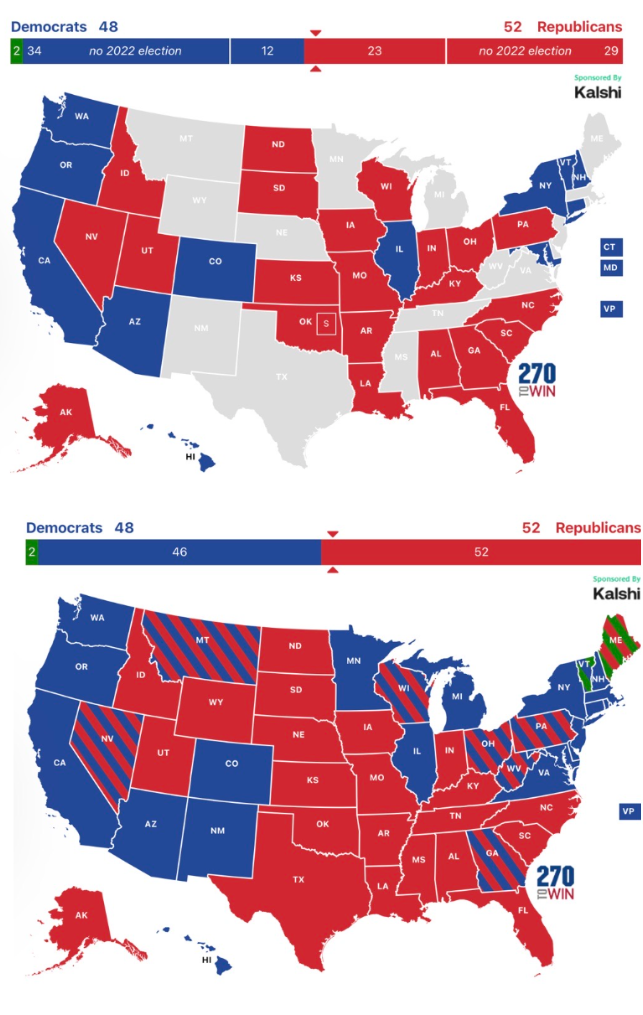2022 Midterms
- Rohan
- Nov 3, 2022
- 4 min read
When one says ‘American Elections’, you probably think of the quadrennial Presidential races that captivate the world’s attention. Two years after every general election, however, there are the Midterm elections which carry just as much political value as the Presidential election itself, and the next one of these is fast approaching on November 8th. In these midterms, there are races in both chambers of the US congress, with ~⅓ of Senate seats up for election and all 435 House seats in contention. Moreover, over 30 US states hold gubernatorial elections at the same time - more similar in nature to Presidential elections yet at the state level. But today, let’s focus on the federal government - I’m going to predict the outcome of both the Senate and House races this year.
If history is any indicator, these elections will end in a Republican rampage. It is often the case that these elections are damaging for the ruling party as all their unfulfilled campaign promises come back to bite them. And this year will be no different for the Democrats who have a government trifecta (the Presidency, Senate and House). Many voters are frustrated by the rate of inflation and increasing amount of crime, so they will look for an alternative - in this case, the Republican party. But just how bad will it be for Biden and his Congressional colleagues? The Senate
Pretty clear favourites have emerged in these races, where 35 out of 100 seats are up for election. This includes close states in the 2020 Presidential Election, such as Arizona and Florida which strongly lean to the Democrats and Republicans, respectively. Three races have emerged at the forefront of this year’s election, and they have the power to define the outcome - Georgia, Nevada and Pennsylvania. Without these states, the Senate is left closely balanced at 49-48 (having been split 50-50 for the past two years) in the Republicans’ favour. Part of what’s made these three states so close is weak candidates running for the Republican party, who are relying on the momentum that their party carries. Georgian Herschel Walker, a former American football player, has come under a lot of scrutiny for his personal history including the fact that he paid for an abortion despite vehemently opposing the Roe v Wade precedent. In Pennsylvania, Doctor and TV Personality Mehmet Oz hasn’t been viewed favourably, in part due to the fact he isn’t even from the state he’s vying to represent. While Nevada’s Republican, Adam Laxalt, is a more palatable candidate, this state has been considered a relatively solid Democratic win for the past decade and has swung back into ‘toss-up’ territory this year. The nature of current affairs helps the Republicans so much that I can’t help but see the Democrats losing all three seats, which would give the Republicans a 52-48 Senate majority. The first map below shows how I expect each state with an election to go, and the second map shows how this would affect the full Senate.

Each state has two Senators, and the second map shows how each state is represented if these predictions are correct. This is similar to the results of the 2020 Presidential Election, with some of the closest states such as Pennsylvania, Wisconsin and Georgia having one Democratic and one Republican senator, while strongholds on either side of the aisle remain politically dominated.
The House
Meanwhile in the lower chamber of the US congress, a dominating performance by Republicans is even more probable. In the House, candidates are less well-known, meaning that people are more likely to vote based on the party next to a candidate’s name rather than the candidate themselves, which hurts the currently unpopular Democrats. All seats are up for election, and I expect the Republicans to do well. Currently, the Democrats hold an eight-seat majority, with 220 seats compared to the Republican’s 212, along with 3 vacant spots. I anticipate that the Republicans will pick up 18 seats this election, 3 of which are currently vacant and 15 of which will come from the Democrats, leaving the GOP with a 25-seat majority. For perspective, only 10 House Republicans voted to impeach Donald Trump after his involvement in the Capitol Riot - in this world where they get this majority, that still wouldn’t be enough despite the Democrats’ support to have put the former President on trial.

The map shows, yet again, the nature of the US’ political divide: large swathes of rural land will tend Republican, and urban centres will fall in the Democrats’ favour. While, based on the map, it may appear that the Republicans have many more than 230 seats, remember that districts are assigned based on population (with ~800,000 residents per district) rather than geographical size, so many of the Republican’s victories will be in geographically large areas. This result will cause a significant change in American leadership - most notably, there’ll be a different Speaker of the House. The role, currently occupied by California Democrat Nancy Pelosi, is 2nd in the Presidential Line of Succession after the Vice President, and is one of the most powerful figures in politics. If the Republicans win, Kevin McCarthy, a California Republican, is expected to take this powerful position.
If the Republicans are to take both chambers of the US Congress, it will become immensely more difficult for President Biden to pass his agenda. Republicans will work hard to stop Biden’s liberal policies that they’ll disagree with, and this includes his aims to codify the right to an abortion, ban assault weapons and mitigate the impacts of climate change. In my opinion, next Tuesday will be a rough day for Liberals in the USA and around the world.
_edited.png)



Comments